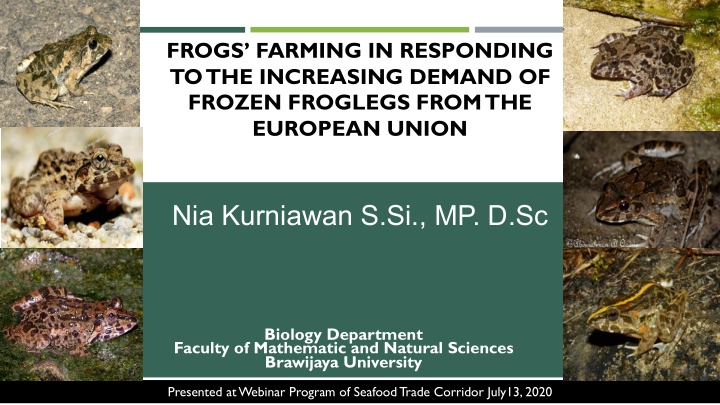



FROGS’ FARMING IN RESPONDING TO THE INCREASING DEMAND OF FROZEN FROGLEGS FROM THE EUROPEAN UNION Nia Kurniawan S.Si., MP. D.Sc Biology Department Faculty of Mathematic and Natural Sciences Brawijaya University Presented at Webinar Program of Seafood Trade Corridor July13, 2020
Background Frog harvesting is now becoming amphibians threats factor beside destruction and habitat degradation, environmental contaminants, and infectious disease (Iskandar, 2018) In many countries in Asia, Africa, and Latin America frogs are collected for subsistence or local consumption (Altherr et al, 2011).
BACKGROUND Frogs’s legs exports from Indonesia in 1969-2002 (Kusrini & Alford, 2006) In Southeast Asia, Fejervarya cancrivora and Limnoncectes macrodon are highly Indonesia is one of major exportir country exploited frogs species for of frogs’ legs (Schmuck, 2000; Kusrini & consumption purpose. Alford, 2006).
Background Destinations of exported frogs’ legs from Indonesia ¡ Export Number of Froglegs in Indonesia (1999 – 2002): 3,831 ton (US$ 11.593 – 15.324 million) ¡ Comprises L. macrodon, F. limnocharis, F. cancrivora, R. catesbiana – mostly belonged to F. cancrivora , with destination of 36 juridictions ¡ Europe was the major importer of Indonesian frogs’ legs (83.2% of the total exported)
Natural History Reproduction and behaviour Morphology ¡ F.cancrivora is medium frogs, a narrow head ¡ Reproduction season in April-August ¡ Preference on rice fields irrigation channels as ¡ The sides of the head have small glandular reproduction spot warts. Parts of the flanks have glandular folds and the lower part has glandular warts. ¡ 500-1000 produced eggs from mature female ¡ Almost-full webbed membrane on hind limbs ¡ Hatched eggs will grow to be juvenile frogs in 45 days ¡ Habitat in rice fields and mangrove forest ¡ Noctural, prey insects and crabs which suitable ¡ Tolerant to high salinity to its mouth Mortality factors ¡ Mortality level when tadpoles stage in the farm is around 10%, on metamorphosis 35 % ¡ Low immune system of frogs on rice fields (effect of herbicide & pesticide), predators ¡ Highest level of eggs production is in rainy season
Areas of Research Mostly, F.cancrivora exported from Indonesia are catched from the wild • It means an exploitation of this species from the field Thus, to fulfill the market demand while maintaining the population of this frog is important • Artificial reproduction of F.cancrivora using mina padi system • Spreading young frogs in the rice fields
Integrated rice-frog farming A mode of ecological farming, is fundamental in realizing sustainable development in agriculture (Fang et al., 2019). ¡ Introducing frogs in the fields could reduce the populations of rice leaf rollers, stem borers, and planthoppers effectively ¡ due to frog predation, and could control rice sheath blight indirectly through reducing insects that transmit disease pathogens (Teng et al, 2015) Introducing frogs in the paddy fields not only showed a potential of pest and disease control but also improved soil ¡ fertility and rice growth (Teng et al, 2015) Variation of tiller number of rice seedlings within the rice growing season.
Research concept RESEARCH CONCEPT
FROGS METAMORPHOSIS R.leptoglossa
Frogs artificial reproduction methods Sperm collection Hormone injecting Keep the frog inside dark room Incubation Insemination Giving food of hatchling frog
TADPOLES RANCHING Gosner stage 42 days Small aquarium Release subadult frogs
Floor plan illustrating the installations to ranching frogs Floor plan illustrating the installations of the greenhouses (tadpole greenhouse and fattening greenhouse) of the commercial frog pond in Brazil
ENVIRONMENT MONITORING ¡ T o prevent the possible poisonous effects of agro-chemicals on frog growth, no any herbicides, pesticides, and chemical fertilizers were applied within the rice growing seasons ¡ Measure of abiotic factor peridiodically.
Challenging of frog farmings in Indonesia
PROBLEMS ¡ Decreasing frogs population caused by exploitation as food ¡ Increasing demand market of frogs' legs ¡ The decline in amphibians leads to an increase in mosquito population ¡ Lack of knowledge about integrated fish / frog rice farming
MINA PADDY SYSTEM/ INTEGRATED FISH FARMING ¡ Mina paddy system is one method to increase the MINA PADI SYSTEM/INTEGRATED FISH FARMING production of agricultural crops by raising fish in the rice fields when growing season. ¡ The system can increase soil quality and reduce pest diseases in rice plants ¡ In several parts of Indonesia, Mina paddy was used by farmers community
Modifications integrated rice-frog farming model in Indonesia Fish net Paddy fields Rice fields dikes Space for ranching frogs Irrigation channels
IMPORTANT THINGS FACTOR OF FROGS FARMING ¡ Artificial Feeding. Feeding is the critical process in culturing frogs successfully. Poorly fed frogs are susceptible to disease and frequently resort to cannibalism ¡ Pond Design. Ponds should be deep enough to protect the adult frogs and tadpoles from extremely hot or cold temperatures ¡ Water Quality and Quantity. An abundant supply of high quality water must be readily available to the frogs throughout the growing season ¡ Diseases The most common disease of frogs, red-leg disease, is due to a bacterial infection ( Aeromonas ), often resulting from overcrowded conditions (Helfrich et al., 2009)
FUTURE PERSPECTIVE OF FROGS FARMINGS IN INDONESIA ¡ Paddy fields in Indonesia are 8,087,393 ha (BPS, 2020). Its potential for the development of sustainable agricultural models ¡ Frog breeding is a relatively recent alternative for an agro industrial ¡ Reduced harvest from the wild ¡ New conservation strategy on highly exploited frogs ¡ Increase the frog population that plays an important role to against rice plant pests ¡ Increase income of farmers community
Thank Y ou
Recommend
More recommend